Unmodified Plant and Waste Oils as Functional Additives in PU Flooring Adhesives: A Comparative Study
Abstract
1. Introduction
2. Results
2.1. Structure of the Oils and Structure–Property Relationships
2.2. Rheological Analysis
2.3. VOC Screening (HS-GC–MS)
2.4. Mechanical Properties
2.4.1. Shear Strength Properties
2.4.2. Tensile Strength Properties
2.5. Leaching Behavior
2.6. Calorimetric Results
3. Discussion
4. Material and Methods
4.1. Materials
4.2. Preparation of Adhesive Samples
4.3. Analytical Methods
4.3.1. Viscosity
4.3.2. VOC Emission Testing
4.3.3. Mechanical Testing
Shear Strength—Hard Elastic Adhesives
- ‑
- 3 days at 23 ± 2 °C/50 ± 5% RH,
- ‑
- 28 days: 7 days under standard conditions, followed by 20 days at 40 ± 2 °C, and 1 additional day under standard conditions.
Tensile Strength
- ‑
- 7 days under standard conditions,
- ‑
- 28 days under standard conditions,
- ‑
- 7 days standard + 20 days at 40 °C + 1 day standard (heat aging).
4.3.4. Leaching Tests of Cured Adhesives
4.3.5. Calorimetric Analysis
4.4. Statistical Analysis
5. Conclusions
Supplementary Materials
Author Contributions
Funding
Institutional Review Board Statement
Informed Consent Statement
Data Availability Statement
Acknowledgments
Conflicts of Interest
References
- Kozicki, M.; Guzik, K. Comparison of VOC emissions produced by different types of adhesives based on test chambers. Materials 2021, 14, 1924. [Google Scholar] [CrossRef] [PubMed]
- Regulation (EU) No 305/2011 of the European Parliament and of the Council of 9 March 2011 Laying Down Harmonised Conditions for the Marketing of Construction Products and Repealing Council Directive 89/106/EEC Text with EEA Relevance. Available online: http://data.europa.eu/eli/reg/2011/305/oj (accessed on 22 July 2025).
- Braish, T.; Tinel, L.; Depelchin, L.; Gaudion, V.; Andres, Y.; Caudron, C.; Antczak, E.; Brachelet, F.; Locoge, N. Evaluation of the seasonal variation of VOC surface emissions and indoor air concentrations in a public building with bio-based insulation. Build. Environ. 2023, 238, 110312. [Google Scholar] [CrossRef]
- Zine Filali, N.; Braish, T.; Andres, Y.; Locoge, N. Measurement reproducibility and storage impact on VOC/SVOC emission rate from decorative materials. Chemosphere 2024, 367, 143607. [Google Scholar] [CrossRef] [PubMed]
- Sardon, H.; Mecerreyes, D.; Basterretxea, A.; Avérous, L.; Jehanno, C. From lab to market: Current strategies for the production of biobased polyols. ACS Sustain. Chem. Eng. 2021, 9, 10664–10677. [Google Scholar] [CrossRef]
- Campana, F.; Brufani, G.; Mauriello, F.; Luque, R.; Vaccaro, L. Green polyurethanes from bio-based building blocks: Recent advances and applications. Green. Synth. Catal. 2024, 6, 217–238. [Google Scholar] [CrossRef]
- Cappello, M.; Filippi, S.; Rossi, D.; Cinelli, P.; Anguillesi, I.; Camodeca, C.; Orlandini, E.; Polacco, G.; Seggiani, M. Waste-cooking-oil-derived polyols to produce new sustainable rigid polyurethane foams. Sustainability 2024, 16, 9456. [Google Scholar] [CrossRef]
- ISO 17178:2013; Adhesives—Adhesives for Bonding Parquet to Subfloor—Test Methods and Minimum Requirements. International Organization for Standardization: Geneva, Switzerland, 2013.
- EN 12457-4:2004; Characterisation of Waste—Leaching—Compliance Test for Leaching of Granular Waste Materials and Sludges—Part 4: One Stage Batch Test at a Liquid to Solid Ratio of 10 L/kg for Materials with Particle Size Below 10 mm (Without or with Size Reduction). International Organization for Standardization: Geneva, Switzerland, 2024.
- ISO 16000-9:2024; Indoor Air—Part 9: Determination of the Emission of Volatile Organic Compounds from Samples of Building Products and Furnishing—Emission Test Chamber Method. ISO: Geneva, Switzerland, 2024.
- Ciastowicz, Ż.; Pamuła, R.; Bobak, Ł.; Białowiec, A. Characterization of vegetable oils for direct use in polyurethane-based adhesives: Physicochemical and compatibility assessment. Materials 2025, 18, 918. [Google Scholar] [CrossRef] [PubMed]
- Märkl, V.; Pflugmacher, S.; Reichert, A.; Stephan, D.A. Leaching of polyurethane systems for waterproofing purposes whilst curing. Water Air Soil. Pollut. 2017, 228, 280. [Google Scholar] [CrossRef]
- Peres, T.L.C.; Ribeiro, F.V.; Aramburu, A.B.; Barbosa, K.T.; Acosta, A.P.; Missio, A.L.; Subhani, M.; Delucis, R.d.A. Polyurethane Adhesives for Wood Based on a Simple Mixture of Castor Oil and Crude Glycerin. Materials 2023, 16, 7251. [Google Scholar] [CrossRef] [PubMed]
- González-Torres, P.; Puentes, J.G.; Moya, A.J.; La Rubia, M.D. Comparative Study of the Presence of Heavy Metals in Edible Vegetable Oils. Appl. Sci. 2023, 13, 3020. [Google Scholar] [CrossRef]
- ISO 3219-2:2021; Rheology—Part 2: General Principles of Rotational and Oscillatory Rheometry. International Organization for Standardization: Geneva, Switzerland, 2021.
- EN 1323:2007; Adhesives for Tiles—Concrete Slabs for Tests. International Organization for Standardization: Geneva, Switzerland, 2007.
- ISO 11885:2007; Water Quality—Determination of Selected Elements by Inductively Coupled Plasma Optical Emission Spectrometry (ICP-OES). International Organization for Standardization: Geneva, Switzerland, 2007.
- ISO 17294-2:2023; Water Quality—Application of Inductively Coupled Plasma Mass Spectrometry (ICP-MS). Part 2: Determination of Selected Elements Including Uranium Isotopes. International Organization for Standardization: Geneva, Switzerland, 2023.
- ISO 12846:2012; Water Quality—Determination of Mercury—Method Using Atomic Absorption Spectrometry (AAS) with and Without Enrichment. International Organization for Standardization: Geneva, Switzerland, 2012.
- ISO 1928:2020; Coal and Coke—Determination of Gross Calorific Value. International Organization for Standardization: Geneva, Switzerland, 2020.
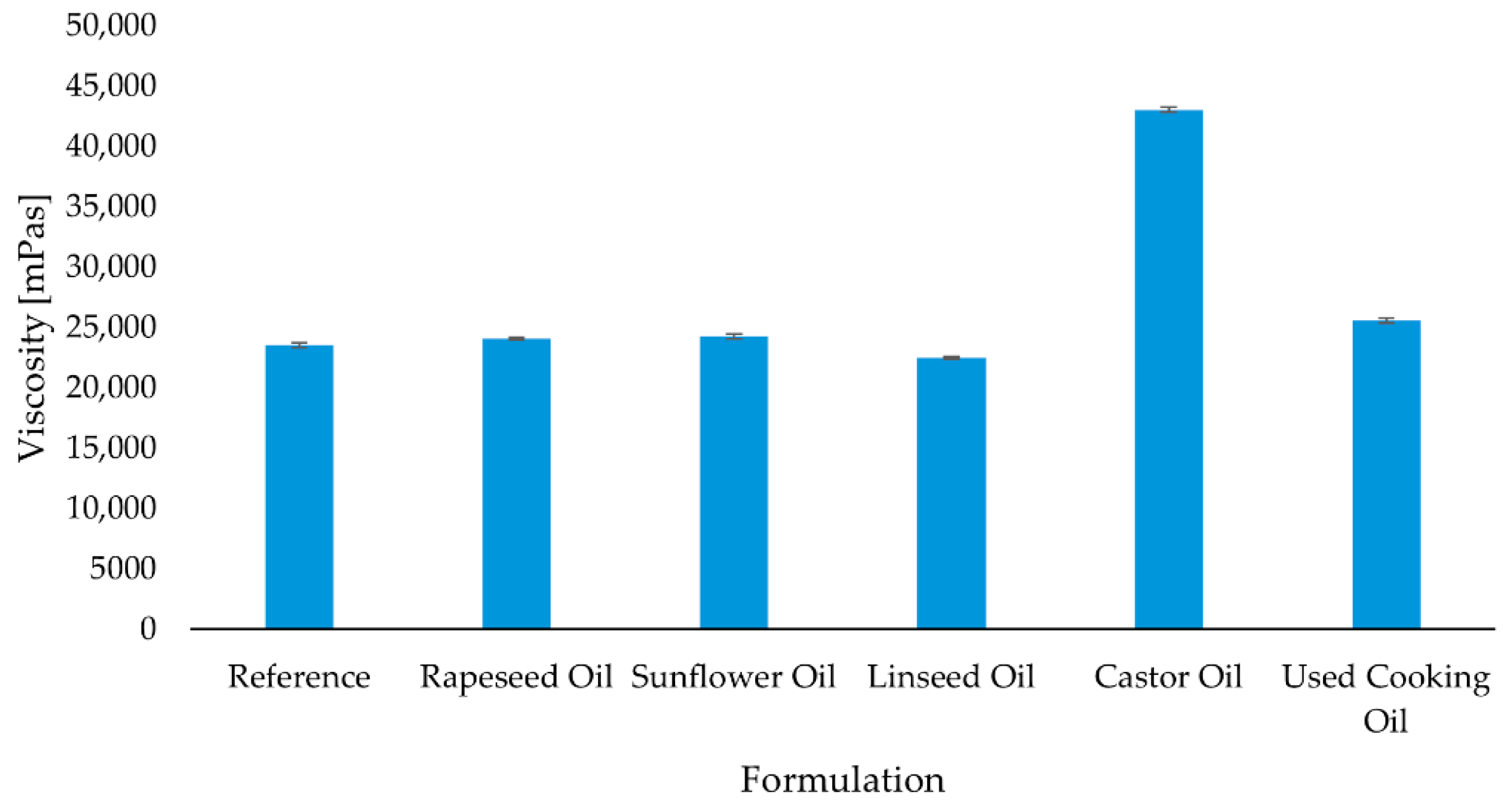
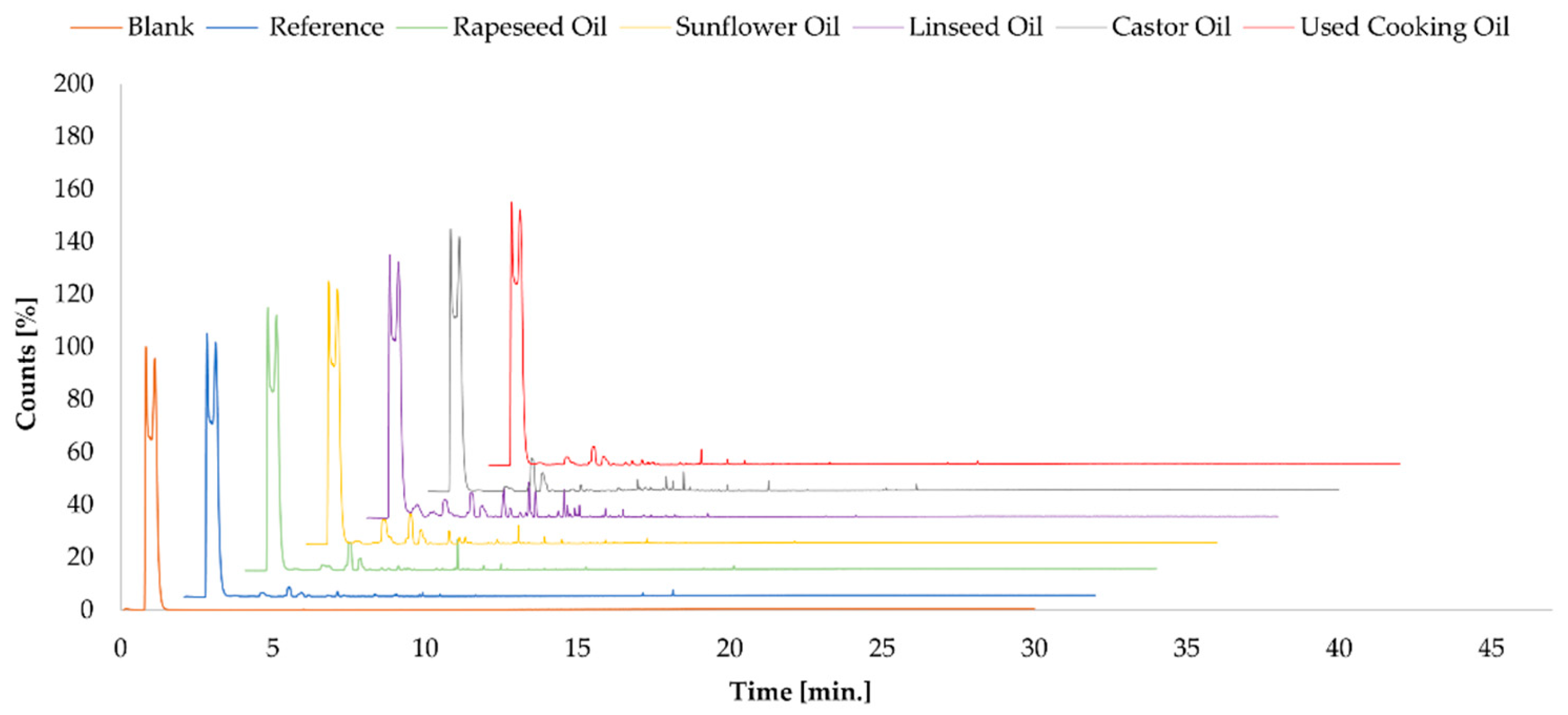
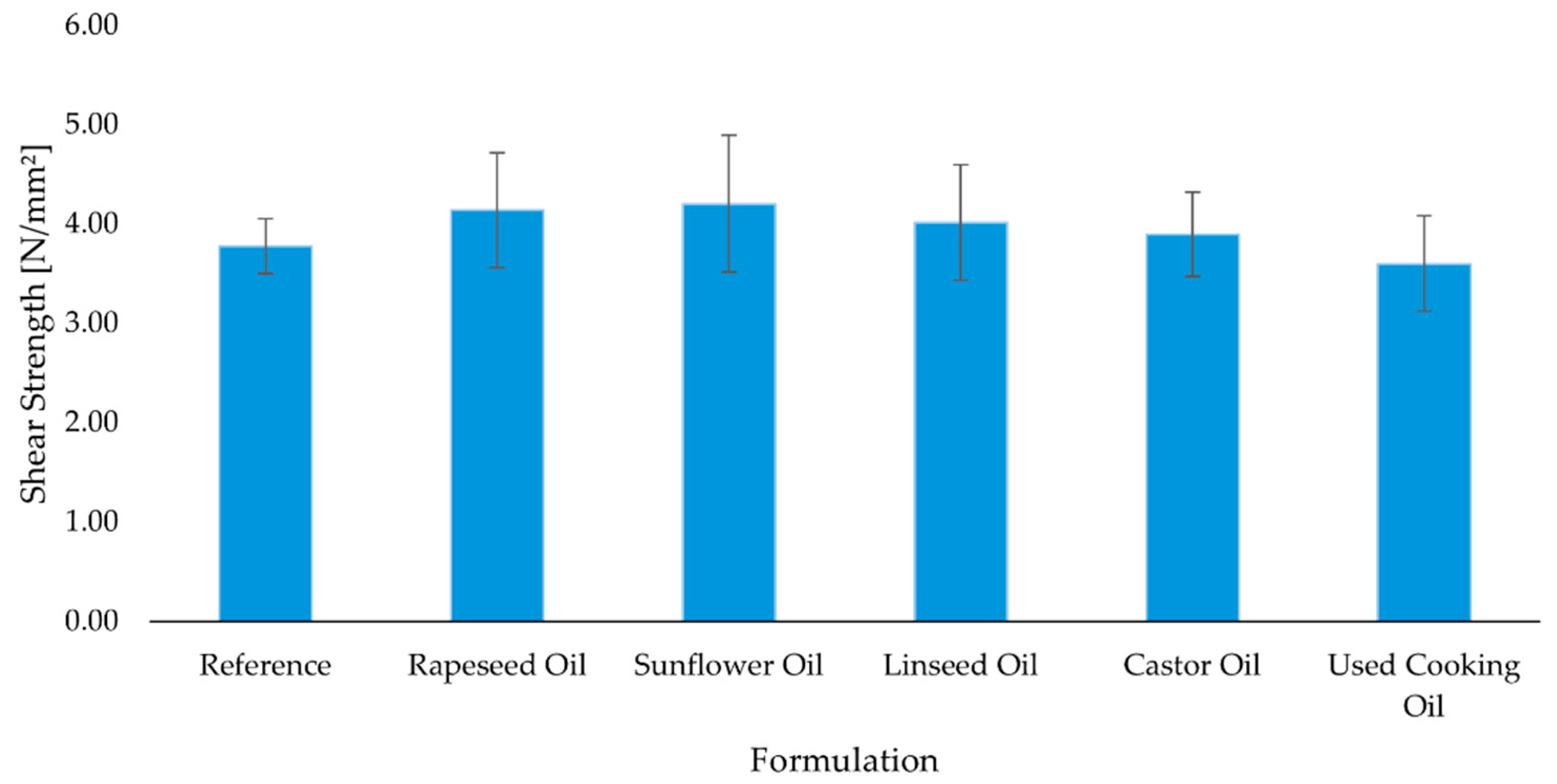

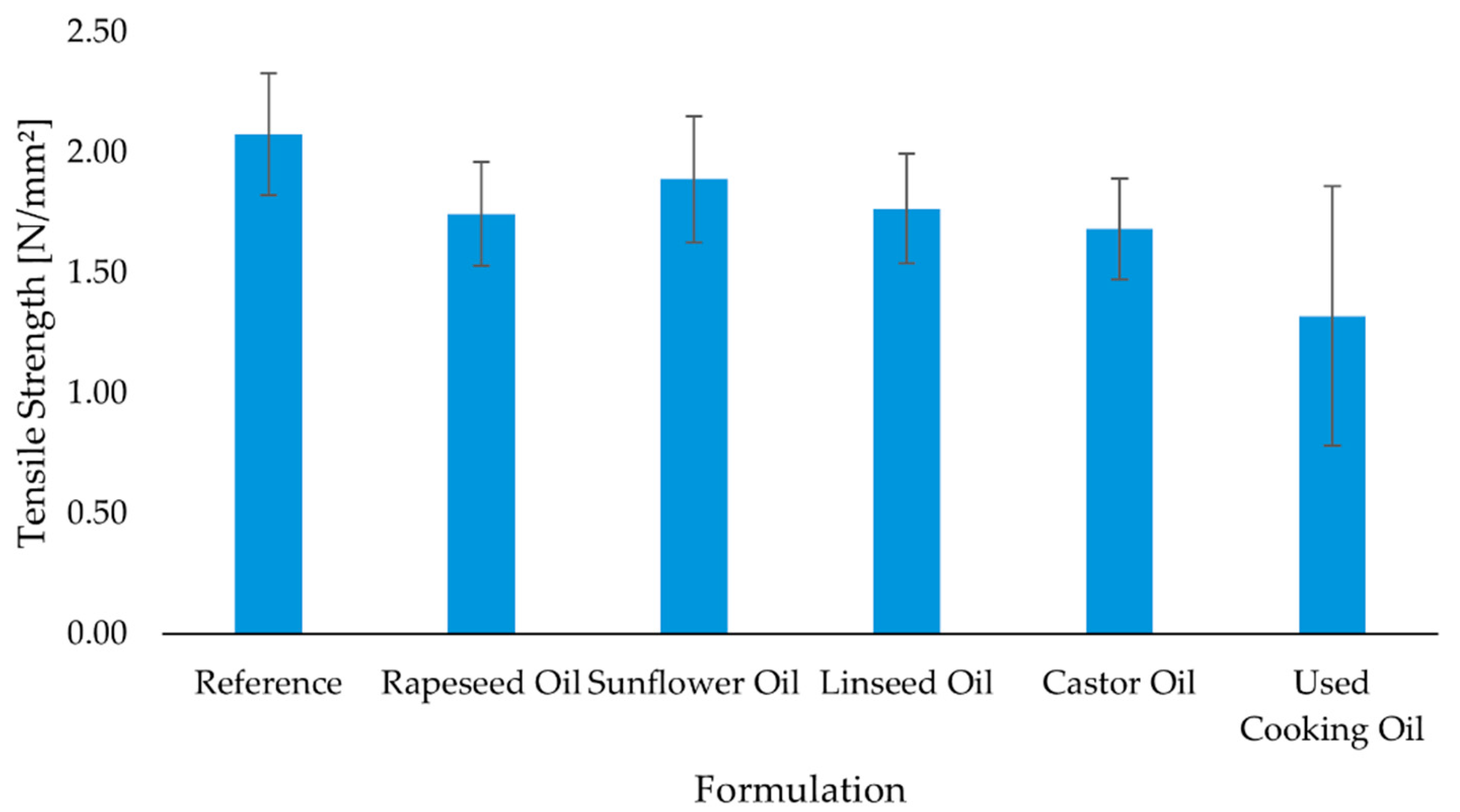
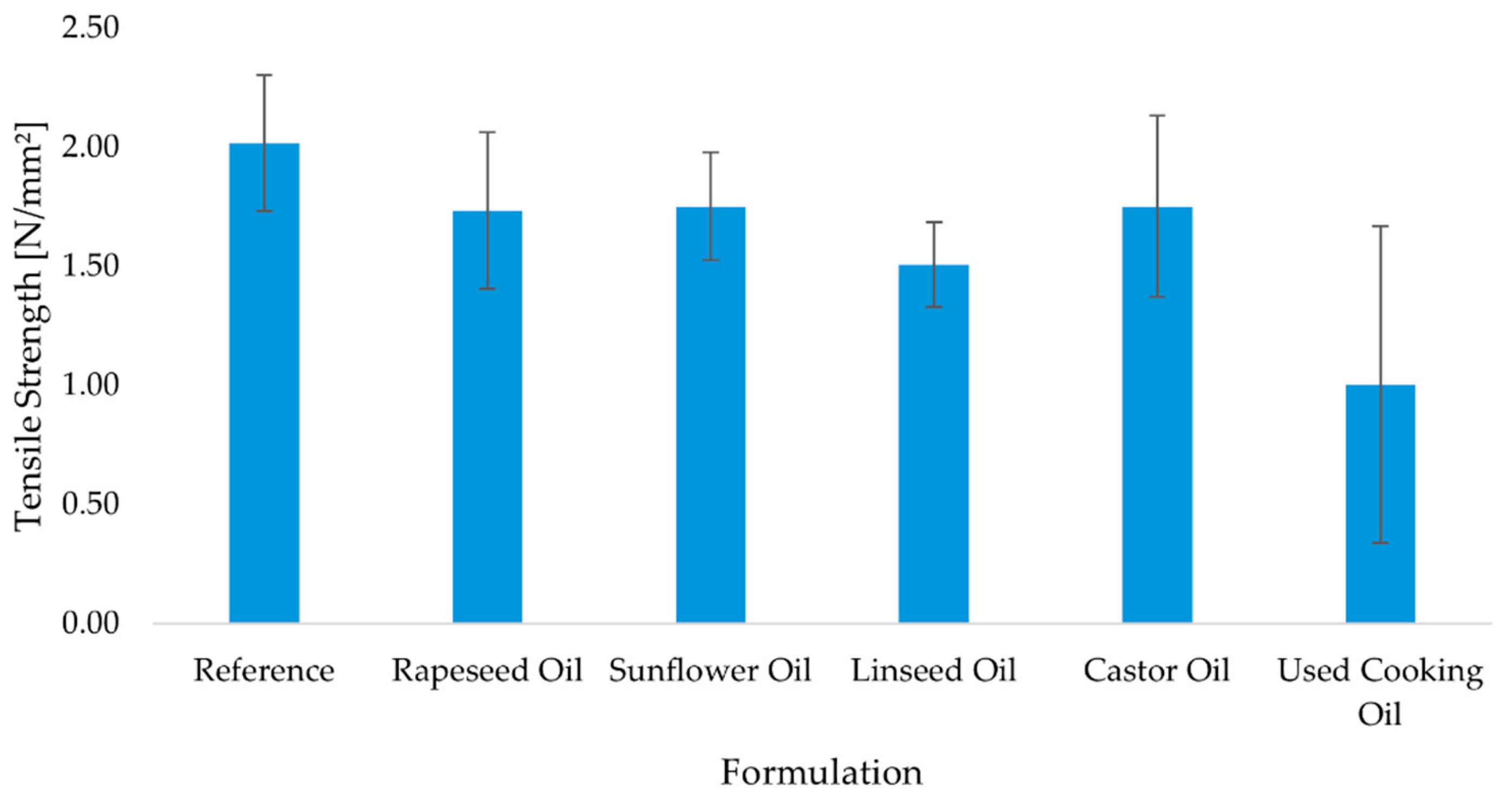

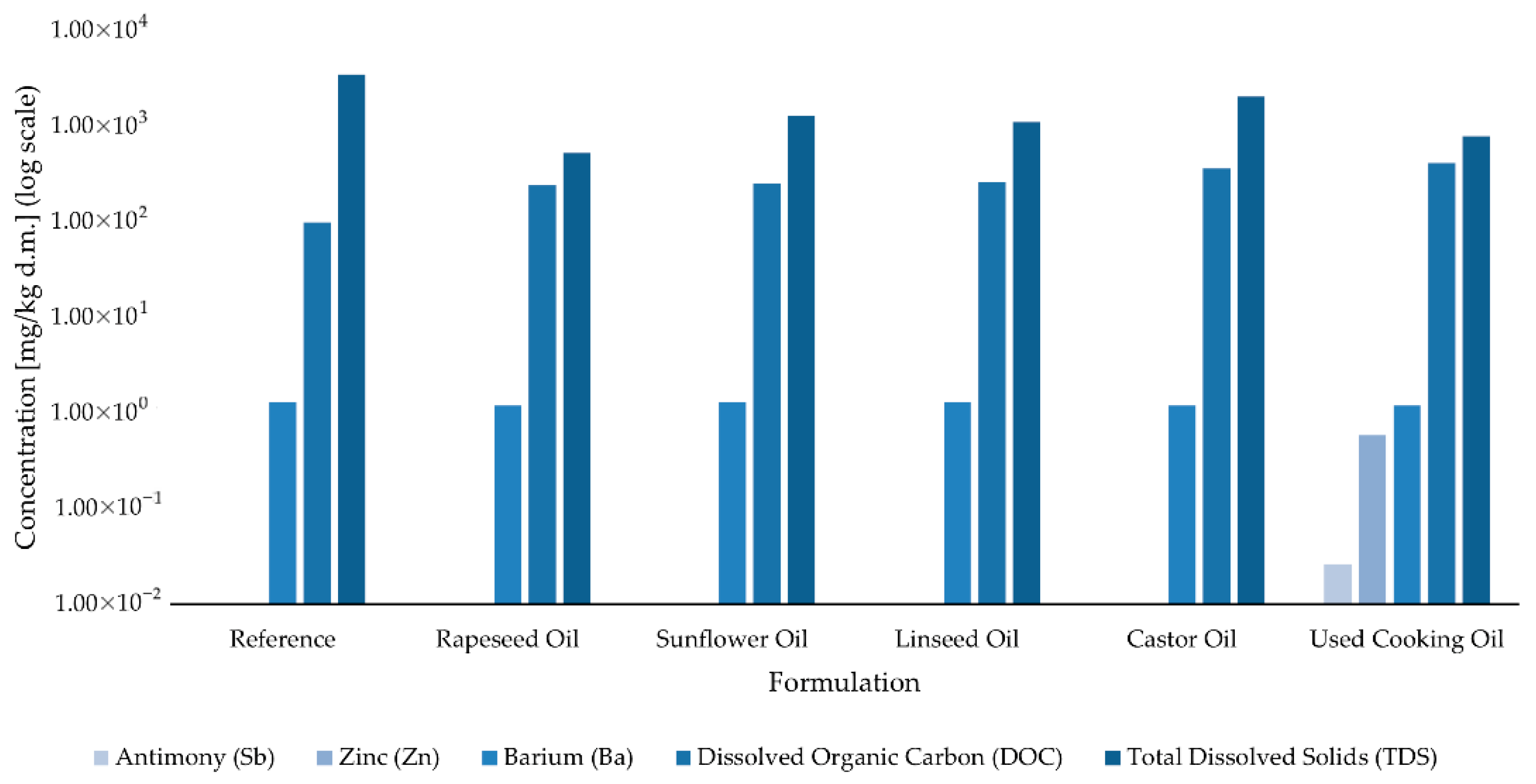
| Rapeseed Oil | Sunflower Oil | Linseed Oil | Castor Oil | Used Cooking Oil | |
|---|---|---|---|---|---|
| Properties | |||||
| Acid Value (AV) [mgKOH/g] | 0.15 | 0.21 | 0.41 | 0.91 | 0.94 |
| Hydroxyl Value (OHV) [mgKOH/g] | 0.66 | 2.92 | 3.73 | 158.04 | 4.22 |
| Iodine Value (IV) [gJ2/100 g] | 110.6 | 124.1 | 173.2 | 85.5 | 98.0 |
| Peroxide Value (PV) [meqO2/kg] | 1.85 | 5.18 | 7.65 | 16.75 | 32.8 |
| Water Content [%] | 0.04 | 0.05 | 0.06 | 0.15 | 0.20 |
| Viscosity [mPas] | 71.8 | 63.2 | 55.5 | 900 | 102.7 |
| Density [g/cm3] | 0.916 | 0.910 | 0.928 | 0.955 | 0.918 |
| Element | Unit | Reference | Rapeseed Oil | Sunflower Oil | Linseed Oil | Castor Oil | Used Cooking Oil |
|---|---|---|---|---|---|---|---|
| Mercury (Hg) | mg/kg d.m. | <0.01 | <0.01 | <0.01 | <0.01 | <0.01 | <0.01 |
| Molybdenum (Mo) | mg/kg d.m. | <0.04 | <0.04 | <0.04 | <0.04 | <0.04 | <0.04 |
| Nickel (Ni) | mg/kg d.m. | <0.04 | <0.04 | <0.04 | <0.04 | <0.04 | <0.04 |
| Lead (Pb) | mg/kg d.m. | <0.1 | <0.1 | <0.1 | <0.1 | <0.1 | <0.1 |
| Selenium (Se) | mg/kg d.m. | <0.025 | <0.025 | <0.025 | <0.025 | <0.025 | <0.025 |
| Copper (Cu) | mg/kg d.m. | <0.04 | <0.04 | <0.04 | <0.04 | <0.04 | <0.04 |
| Arsenic (As) | mg/kg d.m. | <0.025 | <0.025 | <0.025 | <0.025 | <0.025 | <0.025 |
| Chromium (Cr) | mg/kg d.m. | <0.03 | <0.03 | <0.03 | <0.03 | <0.03 | <0.03 |
| Cadmium (Cd) | mg/kg d.m. | <0.005 | <0.005 | <0.005 | <0.005 | <0.005 | <0.005 |
| Chlorides (Cl−) | mg/kg d.m. | <50 | <50 | <50 | <50 | <50 | <50 |
| Fluorides (F−) | mg/kg d.m. | <1.0 | <1.0 | <1.0 | <1.0 | <1.0 | <1.0 |
| Sulfates (SO42−) | mg/kg d.m. | <100 | <100 | <100 | <100 | <100 | <100 |
| Formulation | HHV (J/g) |
|---|---|
| Reference | 15,803 |
| Rapeseed oil | 15,898 |
| Sunflower oil | 16,120 |
| Linseed oil | 15,895 |
| Castor oil | 15,830 |
| Used cooking oil | 15,876 |
Disclaimer/Publisher’s Note: The statements, opinions and data contained in all publications are solely those of the individual author(s) and contributor(s) and not of MDPI and/or the editor(s). MDPI and/or the editor(s) disclaim responsibility for any injury to people or property resulting from any ideas, methods, instructions or products referred to in the content. |
© 2025 by the authors. Licensee MDPI, Basel, Switzerland. This article is an open access article distributed under the terms and conditions of the Creative Commons Attribution (CC BY) license (https://creativecommons.org/licenses/by/4.0/).
Share and Cite
Ciastowicz, Ż.; Pamuła, R.; Pęczek, E.; Telega, P.; Bobak, Ł.; Białowiec, A. Unmodified Plant and Waste Oils as Functional Additives in PU Flooring Adhesives: A Comparative Study. Molecules 2025, 30, 3780. https://doi.org/10.3390/molecules30183780
Ciastowicz Ż, Pamuła R, Pęczek E, Telega P, Bobak Ł, Białowiec A. Unmodified Plant and Waste Oils as Functional Additives in PU Flooring Adhesives: A Comparative Study. Molecules. 2025; 30(18):3780. https://doi.org/10.3390/molecules30183780
Chicago/Turabian StyleCiastowicz, Żaneta, Renata Pamuła, Edyta Pęczek, Paweł Telega, Łukasz Bobak, and Andrzej Białowiec. 2025. "Unmodified Plant and Waste Oils as Functional Additives in PU Flooring Adhesives: A Comparative Study" Molecules 30, no. 18: 3780. https://doi.org/10.3390/molecules30183780
APA StyleCiastowicz, Ż., Pamuła, R., Pęczek, E., Telega, P., Bobak, Ł., & Białowiec, A. (2025). Unmodified Plant and Waste Oils as Functional Additives in PU Flooring Adhesives: A Comparative Study. Molecules, 30(18), 3780. https://doi.org/10.3390/molecules30183780







